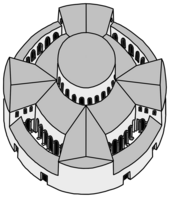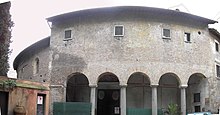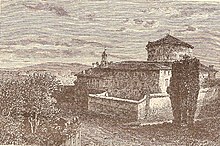Santo Stefano al Monte Celio
| Basilica of Saint Stephen in the Round on the Caelian Hill | |
|---|---|
| |
| Groundbreaking | 5th century |
| Specifications | |
| Length | 80 m (260 ft) |
| Width | 45 m (148 ft) |
| Nave width | 20 metres (66 ft) |
| Clergy | |
| Cardinal protector | Friedrich Wetter |
The Basilica of St. Stephen in the Round on the Caelian Hill (
Since 1985, the
History
This section needs additional citations for verification. (August 2023) |
The earliest church was consecrated by

The church was originally commissioned by

The church was embellished by Pope John I and Pope Felix IV in the 6th century with mosaics and colored marble. It was restored in 1139–1143 by Pope Innocent II, who abandoned the outer ambulatory and three of the four side chapels. He also had three transverse arches added to support the dome,[2] enclosed the columns of the central ambulatory with brick to form the new outer wall, and walled up 14 of the windows in the drum.
In the Middle Ages, Santo Stefano Rotondo was in the charge of the
In 1454,
In 1579, the Hungarian
On a visit to Rome in 1819 J. M. W. Turner made sketches of both the exterior and interior.[5]
The
Exterior

Although the inside is circular, the exterior is on a cruciform plan. The entrance has a portico with five arches on tall ancient granite columns with Corinthian capitals, added in the 12th century, by Pope Innocent II.[2]
Interior
The walls of the church are decorated with numerous frescoes, including those of Niccolò Circignani (Niccolò Pomarancio) and Antonio Tempesta portraying 34 scenes of martyrdom,[5] commissioned by Gregory XIII in the 16th century. Each painting has a titulus or inscription explaining the scene and giving the name of the emperor who ordered the execution, as well as a quotation from the Bible.
Works of art
The altar was made by the Florentine artist
The Chapel of Ss. Primo e Feliciano has mosaics from the 7th century. One of them shows the martyrs Primus and Felician flanking a crux gemmata (jewelled cross). In 648 the chapel was built by Pope Theodore I who brought here the relics of the martyrs and buried them (together with the remains of his father).
Hungarian Chapel
Unlike nationals of other European nations, Hungarians lacked a national church in Rome after the old
The 'Hungarian chapel' is dedicated to
Hungarian experts took part in the ongoing restoration and archeological exploration of the church during the 20th century together with German and Italian colleagues. Notable Hungarian visitors were Vilmos Fraknói, Frigyes Riedl, and László Cs. Szabó, who all wrote about the history and importance of Santo Stefano.
Recent archeological explorations revealed the late-antique floor of the church in the chapel. The floor is composed of coloured marble slabs and was restored in 2006 by an international team led by Zsuzsanna Wierdl.
The frescoes of the chapel were painted in 1776 but older strata of paintings were recently discovered under them.
Burials
Archdeacon
There is a tablet recording the burial here of the Irish king
Mithraeum
Under the church there is a 2nd-century
The mithraeum is being excavated. The remains of the Roman military barracks (from the Severan Age) and the mithraeum under the church remain closed to the public.[when?] The coloured marble bas-relief "Mithras slaying the bull" from the 3rd century is today in the Museo Nazionale Romano.
List of cardinal priests of the church
The titulus S. Stephani in Coelio Monte was cited for the first time in the Roman synod of 499.
- Marcello (499)
- Benedetto (993)
- Crescenzio (1015)
- Sasso de Anagni (1116–1131)
- Martino Cybo (1132–1142)
- Raniero (1143–1144)
- Villano Gaetani (1144–1146)
- Gerardo (1151–1158)
- Gero (1172), pseudocardinal of the Antipope Calixtus III
- Vibiano (1175–1184)
- Giovanni di Salerno (1190–1208)
- Robert of Courçon(or de Corzon, or Cursonus) (1212–1219)
- Michel Du Bec-Crespin (1312–1318)
- Pierre Le Tessier (1320–1325)
- Pierre de Montemart (1327–1335)
- Guillaume d'Aure, O.S.B. (1339–1353)
- Élie de Saint-Irier (or Saint Yrieux) (1356–1363)
- Guillaume d'Aigrefeuille le Jeune (1367–1401)
- Gugilemo d'Altavilla (1384–1389)
- Angelo Cino (or Ghini Malpighi) (1408–1412)
- Pierre Ravat (or Rabat) (1408–1417), pseudocardinal of the Antipope Benedict XIII
- Pierre of Foix, (1417–1431)
- Jean Carrier (1423-c. 1429), pseudocardinal of the Antipope Benedict XIII
- Vacant (1431–1440)
- Renault de Chartres(or Renaud) (1440–1444)
- Jean d'Arces (1444–1449), pseudocardinal of the Antipope Felix V
- Jean Rolin (1448–1483)
- Giovanni Giacomo Sclafenati (1483–1484); in commendam (1484–1497)
- Vacant (1497–1503)
- Jaime Casanova (1503–1504)
- Antonio Pallavicini Gentili (or Antoniotto), in commendam (1504–1505)
- Antonio Trivulzio, senior (1505–1507)
- Melchior von Meckau (1507–1509)
- François Guillaume de Castelnau-Clermont-Ludève (1509–1523)
- Bernardo Clesio (1530–1539)
- David Beaton (1539–1546)
- Giovanni Morone (1549–1553)
- Giovanni Angelo Medici (1553–1557) later Pope Pius IV
- Fulvio Giulio della Corgna (1557–1562)
- Girolamo da Correggio (1562–1568)
- Diego Espinosa (1568–1572)
- Zaccaria Delfino (1578–1579)
- Matteo Contarelli (1584–1585)
- Federico Cornaro (1586–1590)
- Antonio Maria Sauli (1591–1603)
- Giacomo Sannesio (1604–1621)
- Lucio Sanseverino (1621–1623)
- Bernardino Spada (1627–1642)
- John de Lugo (1644)
- Giovanni Giacomo Panciroli (1644–1651)
- Marcello Santacroce Publicola (1652–1674)
- Bernardino Rocci (1675–1680)
- Raimondo Capizucchi (1681–1687)
- Francesco Bonvisi (1689–1700)
- Giovanni Battista Tolomei (1712–1726)
- Giovanni Battista Salerno (1726–1729)
- Camillo Cybo (1729–1731)
- Antonio Saverio Gentili (1731–1747)
- Filippo Maria Monti (1747–1754)
- Fabrizio Serbelloni (1754–1763)
- Pietro Paolo Conti (1763–1770)
- Ludovico Calini (1771–1782)
- Vacant (1782–1786)
- Niccolò Colonna di Stigliano (1786–1796)
- Étienne-Hubert de Cambacérès (1805–1818)
- Vacant (1818–1834)
- Francesco Tiberi (1834–1839)
- Vacant (1839–1845)
- Fabio Maria Asquini (1845–1877)
- Manuel García Gil (1877–1881)
- Paul Melchers (1885–1895)
- Sylvester Sembratovych(1896–1898)
- Jakob Missia (1899–1902)
- Lev Skrbenský z Hříště (1902–1938)
- Vacant (1938–1946)
- József Mindszenty (1946–1975)
- Vacant (1975–1985)
- Friedrich Wetter (1985-incumbent)
See also
References
- OCLC 37878669.
- ^ a b c "The Church of Santo Stefano Rotondo al Celio", Turismo Roma, Major Events, Sport, Tourism and Fashion Department
- .
- ^ Aldásy, Antal. "Stephan Szántó (Arator)." The Catholic Encyclopedia Vol. 14. New York: Robert Appleton Company, 1912
 This article incorporates text from this source, which is in the public domain.
This article incorporates text from this source, which is in the public domain.
- ^ a b Moorby, Nicola. "J.M.W. Turner: Sketchbooks, Drawings and Watercolours", Tate, May 2008
- ^ Érszegi, Géza (2013). "A Paenitentiaria Apostolica dokumentumai „in partibus"" (PDF). In Homoki-Nagy, Mária (ed.). Ünnepi kötet Dr. Blazovich László egyetemi tanár 70. születésnapjára. Szeged: Szegedi Tudományegyetem. p. 210.
- doi:10.1093/ref:odnb/20452. (Subscription or UK public library membershiprequired.)
Further reading
- Macadam, Alta. Blue Guide Rome. A & C Black, London (1994), ISBN 0713639393
- Federico Gizzi, Le chiese medievali di Roma (Rome, Newton Compton, 1998).
- H. Brandenburg und J. Pál (edd), Santo Stefano Rotondo in Roma. Archeologia, storia dell'arte, restauro. Archäologie, Bauforschung, Geschichte. Akten der internationalen Tagung (Rom 1996) (Wiesbaden, 2000).
- ISBN 9780870991790
External links
- Photos of the discovered Roman floor, with Hungarian text only
- Official Homepage of the Church Archived 2018-09-16 at the Wayback Machine
- Interactive Nolli Map
![]() Media related to Santo Stefano Rotondo at Wikimedia Commons
Media related to Santo Stefano Rotondo at Wikimedia Commons
| Preceded by Santa Sofia a Via Boccea |
Landmarks of Rome Santo Stefano al Monte Celio |
Succeeded by Santa Teresa, Rome |
